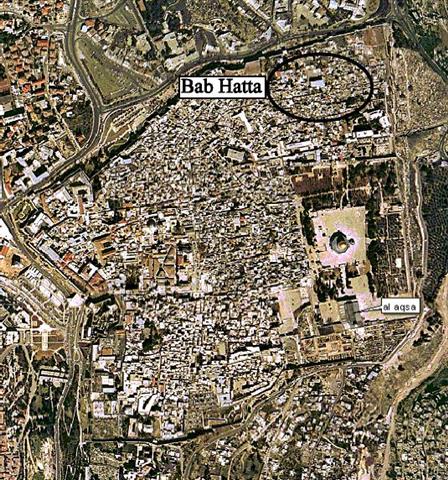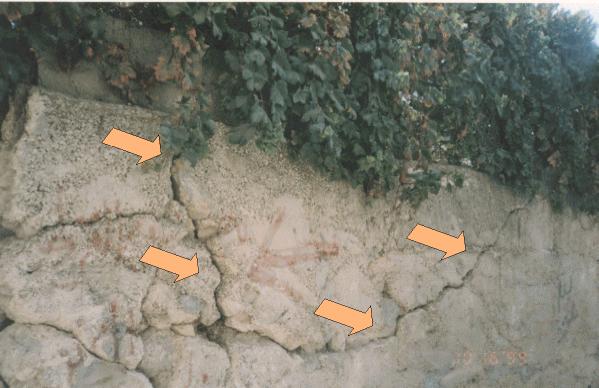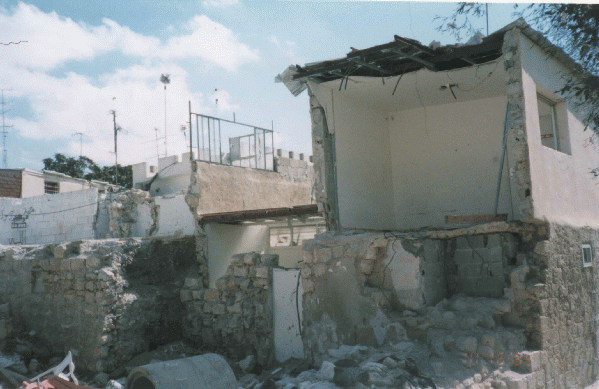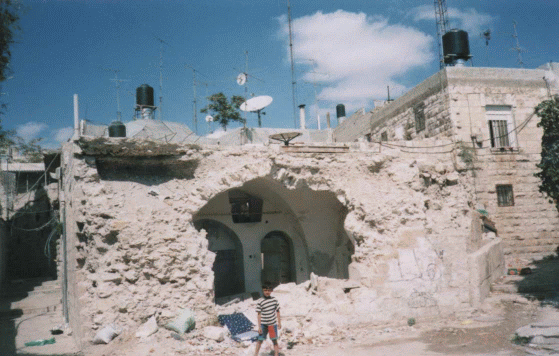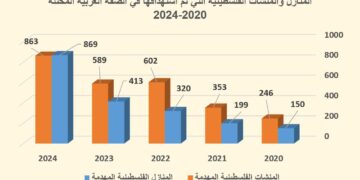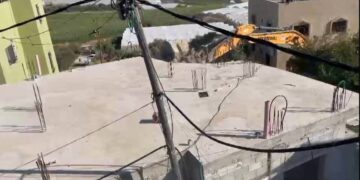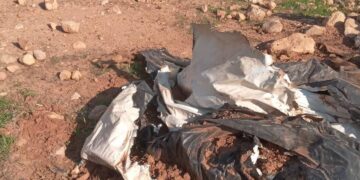crowded Arab neighborhood in the Old City.
In 1986 the Sewer Department of Jerusalem Municipality carried out a series of diggings in the neighborhood. These diggings were 3 meters deep which is considered to be a dangerous level to reach due to two reasons. The first reason is that the houses in that area are built without any concrete foundations. They are built directly on the sand. Digging so deep would endanger the houses and put them in a serious situation, as sand layers tend to shift around under the pressure of the houses built atop them. The second reason is that Jerusalem is made atop of a number of ground layers. Each layer contains a number of the artifacts of the historical eras in which the layer was formed. The diggings for three meters caused a great damage to the existing artifacts.
After the digging work was completed, the holes created by the diggings were covered only by sand. Neither concrete nor steel were used to ensure the proper closing of the holes and other similar measures were not taken to prevent these holes from reopening.
The years after the initial diggings have witnessed a number of additional diggings to install TV and phone cables in the same location while leaving the holes open to be filled with garbage, water, and mud. Sewer and rainwater were also collected in such holes causing the bases of the buildings to get weaker and weaker as time went by. In addition, the sewer pipes and water lines installed by the Municipality could not hold the weight of the shifted soil surrounding it and caused the pipes to burst, causing more damage to the bases of the house in the process.
The owners of the affected houses went to the Municipality to demand that the holes be covered with concrete to prevent the leakage of the water and to allow the residents to reinforce the bases of their houses and to renovate the houses. The Municipality refused these requests flat out. Yet, and after constant demand and a number of written protests, the Municipality put a layer of concrete in 1989 atop of the holes without any prior scientific studies to determine where and how much concrete should be used to ensure proper prevention of leakage. As a result, the soil continued moving away from under the bases of the house, cracks in the houses continued to widen, and the walls of the houses began to come apart.
The climax of the situation took place on the 7th of February 1999, when the residents of the houses heard a loud blast of water running beneath them. When the engineers of the Municipality came to the location they have discovered that the building pressure beneath the house have transferred a great deal of the soil and that most of the houses have lost their sandy bases. That meant that the houses were virtually standing in the air. The initial check carried out by engineers of the surrounding houses proved similar conditions.
The Response of the Jerusalem Municipality
Instead of repairing the damage it caused, the Municipality issued orders to evacuate the houses in preparation to demolish the most affected ones. The evacuated people, 39 in total, resided in Al Qazaz hotel on the expenses of the Municipality. Twenty days passed by before the residents were moved once again to the Comoddor hotel. The following table lists the names of the families affected by the practices of the Municipality in Bab Hatta
|
No. |
Head of Family |
No. of Flats |
No. of Rooms |
No. of Family Members |
No. of Children |
|
1 |
Hussein Yousef Abu Ghazaleh |
2 |
6 |
10 |
4 |
|
2 |
Badia'a Othman Hammo |
4 |
4 |
9 |
2 |
|
3 |
Abdel Qader Marar |
1 |
3 |
5 |
0 |
|
4 |
Abdel Khaleq Abdel Qader Marar |
1 |
3 |
10 |
8 |
|
5 |
Adel Abdel Qader Marar |
1 |
1 |
5 |
3 |
|
TOTAL |
|
6 |
17 |
39 |
17 |
In the absence of the residents, the Municipality demolished a number of rooms in the affected locations according to the following table:
|
NO. |
Head of Family |
Total No. of Rooms |
Number of Rooms Demolished |
|
1 |
Hussein Yousef Abu Ghazaleh |
6 |
4 plus utility rooms |
|
2 |
Badia'a Othman Hammo |
4 |
2 plus utility rooms |
|
3 |
Abdel Qader Marar |
3 |
2 |
|
4 |
Abdel Khaleq Abdel Qader Marar |
3 |
2 |
|
5 |
Adel Abdel Qader Marar |
1 |
0 |
|
|
TOTAL |
17 |
10 |
Scene of demolished rooms in Bab Hatta
While residing in the hotel, the residents found out that the Municipality has stopped paying the bills for the hotel. As a result, residents were obliged to return to live near the demolished rooms endangering, in the process, themselves and their children. Ever since then, the Municipality has been neglecting its responsibility towards these residents, least of which the renovation of remaining rooms and the compensation for damage done for the demolished rooms. The responsibilities of the Municipality include ensuring safety of the residents living within its boundaries. Yet, it seems that in the case of East Jerusalem matters are not running according to normal. As one lady puts it ' There are no Municipality workers in East Jerusalem to collect garbage or to repair damaged roads. On the other hand, one finds police and Special Forces and Municipality workers confiscating the fridge and the gas burner and the washer machine if the Arnona and the income tax were not paid on time.'
Analysis:
After careful examination of the events that took place in the above-mentioned area, the center has noticed that the actions of the Municipality with regard to the houses in Bab Hatta were not random. They were part of a scheme carried out by a number of Israeli bodies to increase the number of Jews living in the part of the Old City. The center noticed that the location of the partially demolished houses is very close to the two other locations that have witnessed colonization activities. They include:
1. Islamic Waqf property which was taken over by Aterete Cohanim Movement on the 24th of May 1998. On that day the Movement tried to install the corner stone for a new Jewish settlement on the property. After the strong reaction of the Palestinian residents, Mayor Ehud Olmert stopped the building process and removed what was built in exchange for a deal with the Movement giving them the right to carry out excavation work in the site.
2. Burj Al Laqlaq property. This property, owned by a number of Palestinian Jerusalemites, witnessed on the 26th of August 1996 the demolishing of the headquarter of a not-for-profit organization for the disabled.
Prepared by:
The Land Research Center
LRC


